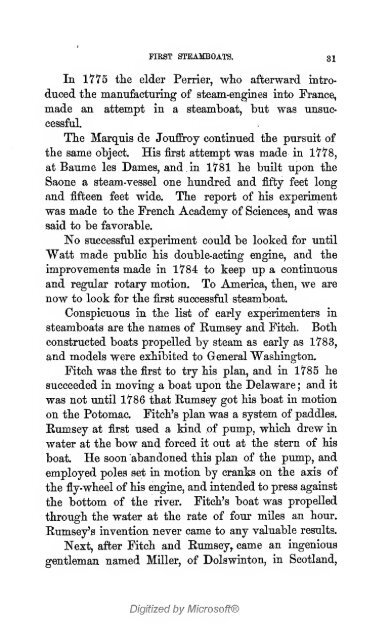The history of the first locomotives in America. From original ...
The history of the first locomotives in America. From original ...
The history of the first locomotives in America. From original ...
Create successful ePaper yourself
Turn your PDF publications into a flip-book with our unique Google optimized e-Paper software.
FIRST STEAMBOATS. 31<br />
In 1775 <strong>the</strong> elder Perrier, who afterward <strong>in</strong>troduced<br />
tlie manufactur<strong>in</strong>g <strong>of</strong> steam-eng<strong>in</strong>es <strong>in</strong>to France,<br />
made an attempt <strong>in</strong> a steamboat, but was unsuc-<br />
cessful.<br />
Tlie Marquis de Jouflfroy cont<strong>in</strong>ued <strong>the</strong> pursuit <strong>of</strong><br />
<strong>the</strong> same object. His <strong>first</strong> attempt was made <strong>in</strong> 1778,<br />
at Baume les Dames, and <strong>in</strong> 1781 he built upon <strong>the</strong><br />
Saone a steam-vessel one hundred and fifty feet long<br />
and fifteen feet wide. <strong>The</strong> report <strong>of</strong> his experiment<br />
was made to <strong>the</strong> French Academy <strong>of</strong> Sciences, and was<br />
said to be favorable.<br />
No successful experiment could be looked for untU<br />
Watt made public his double-act<strong>in</strong>g eng<strong>in</strong>e, and <strong>the</strong><br />
improvements made <strong>in</strong> 1784 to keep up a cont<strong>in</strong>uous<br />
and regular rotary motion. To <strong>America</strong>, <strong>the</strong>n, we are<br />
now to look for <strong>the</strong> <strong>first</strong> successful steamboat.<br />
Conspicuous <strong>in</strong> <strong>the</strong> list <strong>of</strong> early experimenters <strong>in</strong><br />
steamboats are <strong>the</strong> names <strong>of</strong> Rumsey and Fitch. Both<br />
constructed boats propelled by steam as early as 1783,<br />
and models were exhibited to General Wash<strong>in</strong>gton.<br />
Fitch was <strong>the</strong> <strong>first</strong> to try his plan, and <strong>in</strong> 1785 he<br />
succeeded <strong>in</strong> mov<strong>in</strong>g a boat upon <strong>the</strong> Delaware ; and it<br />
was not until 1786 that Eumsey got his boat <strong>in</strong> motion<br />
on <strong>the</strong> Potomac. Fitch's plan was a system <strong>of</strong> paddles.<br />
Rumsey at <strong>first</strong> used a k<strong>in</strong>d <strong>of</strong> pump, which drew <strong>in</strong><br />
water at <strong>the</strong> bow and forced it out at <strong>the</strong> stern <strong>of</strong> his<br />
boat. He soon abandoned this plan <strong>of</strong> <strong>the</strong> pump, and<br />
employed poles set <strong>in</strong> motion by cranks on <strong>the</strong> axis <strong>of</strong><br />
<strong>the</strong> fly-wheel <strong>of</strong> his eng<strong>in</strong>e, and <strong>in</strong>tended to press aga<strong>in</strong>st<br />
<strong>the</strong> bottom <strong>of</strong> <strong>the</strong> river. Fitch's boat was propelled<br />
through <strong>the</strong> water at <strong>the</strong> rate <strong>of</strong> four miles an hour.<br />
Eumsey's <strong>in</strong>vention never came to any valuable results.<br />
Next, after Fitch and Eumsey, came an <strong>in</strong>genious<br />
gentleman named Miller, <strong>of</strong> Dolsw<strong>in</strong>ton, <strong>in</strong> Scotland,<br />
Digitized by Micros<strong>of</strong>t®
















